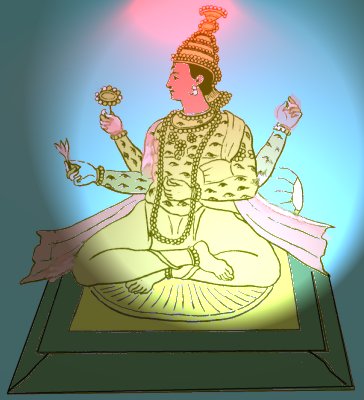



Image from Moor.




Image
from Moor.
Basic Description: King of the gods, god
of thunder and rain, god of war
Alternate Names: Sakra (Powerful),
Vajri (the Thunderer), Puramdara (Destroyer of Cities),
Meghavahana (Rider of the Clouds), Svargapati (the Lord of
Heaven), King-of-the-gods (Suradhipa), Lord-of-Heavenly-Craftsmen
(Rbhuksa), Indra-the-great (Mahendra), the MAgnificant (Maghavan), Lord-of-the-spheres
(Vasava), Riding-upin-the-Clouds (Megha-vahana), Glorified-in-a-hundred-sacrifices
(Sata-kratu), Lord-of-the-gods (Deva-pati), Regent-of-space (Divas-pati), Lord-of-the-Winds
(Marutvan), Lord-of-Paradise (Svarga-pati), Leader of the Celestial Host (Jisnu),
the Owl (Uluka), the Fearful Archer (Ugra-dhanvan) Indra is often associated
with Jupiter
History/Practices:
From Vedic times, Indra has been the supreme ruler of the gods. He has
more hymns addressed to him in the Rig Veda than any other god. He is the leader
in war and the strongest of all beings. Indra protects humans from evil forces.
His happiness is legendary and he was considered the heart of the universe.
He is the nature of cosmic and animal life energy.
Indra was considered the god of war. He protected the
warriors and took them into his heaven, Svarga, after their deaths. Svarga, his movable heavenly court, is located in the
clouds surrounding the highest peak of the sacred mountain Meru. In Svarga,
there is an enormous hall when slain warriors went after death. Here, Indra
and the beautiful Indrani rule. No sorrow, suffering, or fear were allowed in
Indra's home, just dancing and contests. In Brahamanic and later times, Indra is supplanted by
Vishnu and Shiva.
Iconography:
Usually reddish in color, sometimes gold and tawny, with 2 to 4 long arms,
riding an albino elephant, holding a lightning bolt (Vajra), bow, net, hook,
conch shell, noose or sword.
Mythology:
His father was sky god Dyaus Pita and mother was the earth goddess Prthivi;
he was born fully grown and fully armed. His sons are Jayanta, Midhusa, Nilambara, Rbhus, Rsabha,
Sitragupta, and, most importantly, Arjuna. His anger and might are to be feared. Indra, in cold
blood, murdered the humble and wise son of a priest, just because he grew afraid
the young ascetic's powers were growing too strong
Indra's most notable exploit was a battle against asura
Vritra. Vritra, in the form of a dragon, stole all the water in the world for
himself. Upon hearing what had happened, Indra vowed to take back the life-giving
liquid. He rode forth to meet Vritra, consuming vast quantities of Soma in order
to retain the strength to defeat Vritra. Indra smashed through Vritra ninety-nine
fortresses, and then came upon the dragon. The two clashed, and after a long
battle Indra was able to destroy his powerful enemy, split open the demon, and
cause the waters to fall from the skies. So Indra became a hero to all people,
and the gods elected him their king for his victory.
In the Mahabharata, Indra is pursued by a terrible female
goddess, Brahminicide (who rose up out of the dead Vritra). She, a Brahman,
relentlessly chased him, overtook him in his chariot, and clung to him; he hid
inside a lotus blossom, but could not dislodge her. Finally, Indra went to Brahma
and explained what happened. Since killing a Brahman was a crime, Brahma
agreed to forgive Indra if he did a penance. Indra’s punishment, according to some myths, was to acquiesce his throne and
become a woman of low birth.
Riding Animal: Indra is seen riding Airavata, an
albino elephant with four tusks who is always victorious. He is sometimes carried
in a golden chariot (Jaitra) drawn by 10,000 horses. (Reference to the sun god)
Other times, he rides his horse Loud-Neigh (Uccaihsravas).
Consort: Prthivi
(his mother), Indrani (his wife—also Aindri or Saci), Ahalya (wife of his Guru—Gautama,
Indra had an affair with her)
Other References on the Karma-to-Grace website: Is
there a Devil in Hinduism? Is
the Trinity of Christianity and Hinduism the same?
Sources:
Danielou, Alain. Myths and Gods of India. Rochester:
Inner Traditions. 1991.
Moor, Edward. The Hindu Pantheon. LA: Philosophical
Research Society. 1976.
Thomas, P. Epics, Myths and Legends of India.
Bombay: D.B. Taraporevala Sons & Co. 1957.
Return to Table of Contents